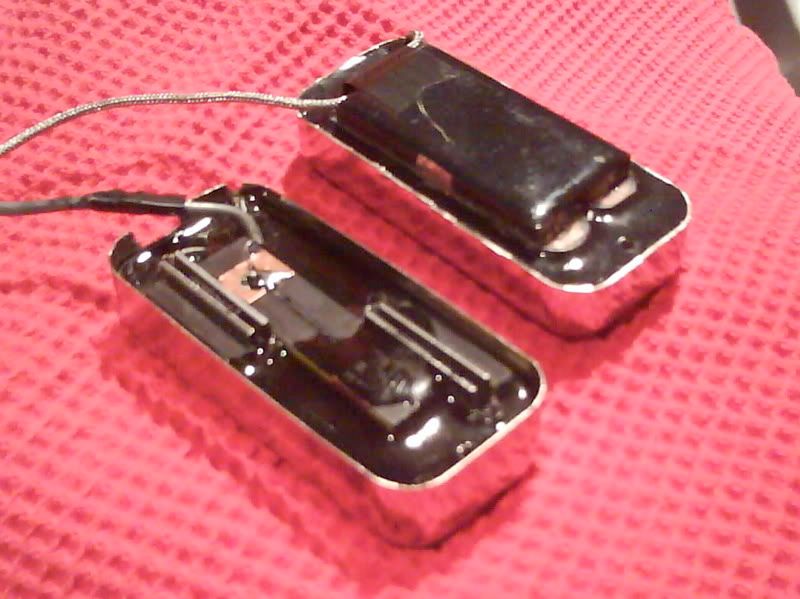Anybody seen this before? It supposedly came out of a 70's Thunderbird bass. It's not the usual sidewinder, kind of a perverted P bass style. Anyway, here is some analysis I did for its owner.
An unusual pickup designtwo coils, each serving two strings, like a P bass. But each coil is on the opposite pole of a central magnet shared by both coils. And each coil has an secondary magnet mounted to the outside of the coil, which energizes one of the two pole pieces that each coil has. So, a total of three magnets, four pole pieces, and 2 coils.
The two coils should be wired out of phase to cancel induced mag field noise, and since they are on opposite poles of the magnet, the string signals will still be in phase, like in all humbuckers.
In pix1, we see the central magnet, where the yellow paint is indicating the N pole of the magnet. The 2 pieces of copper foil are to ground the steel pole pieces, so they will not pick up noise. The foil wrap touches the steel at the interface between the central magnet and the pole piece . One coil was where all the damage is, and the other is at the other side of the magnet where you see the 2 steel pole pieces.
In pix2 you can see the secondary magnet, its purpose is to magnetically energize the lower of the two pole pieces (it isn't touching the central magnet, so it isn't energized by ithence the need for another magnet). Why not a single steel pole piece? I suspect it is an attempt to reduce eddy current losses in the pole piece, tho I doubt it is necessary, and a single pole piece would make the pickup much easier to build.
In coil1 you can see the 2 pole pieces, the secondary magnet, and the copper coil wires.
Specs:
Central magnet: Ferrite, .2 X .55 X 2.35 ~140mT pole strength
Secondary magnet: Ferrite, .2 X .2 X 1.2 (about half as long 'cause it only covers one coil) ~110mT pole strength.
Pole pieces: cold rolled steel, .062 X .7 X 1.135
Bobbin: molded plastic, .385 tall, .56 wide, length over all 1.5. Winding area .3 tall,.285 wide, 1.26 long. Pole slot 1.13 long X .185 wide.
Coil: wound with AWG 44 solderable. Intact coil measures 5.50Kohm, L 2.628H, Q 2.641 at 1kHz. (this is with the iron inside, raw coil would be lower L and Q). I estimate between 4500 and 6500Turns. You'd have to wind one and sneak up on the final value.
Probably a pretty powerful and yet bright pickup. The overall R would be about 10K (2 coils) and about 5.2H. Not much losses due to the 2 pole pieces and the ferrite magnets (much less lossy than alnico)
Maybe not very warm sounding, ferrites tend not to sound that way.
An unusual pickup designtwo coils, each serving two strings, like a P bass. But each coil is on the opposite pole of a central magnet shared by both coils. And each coil has an secondary magnet mounted to the outside of the coil, which energizes one of the two pole pieces that each coil has. So, a total of three magnets, four pole pieces, and 2 coils.
The two coils should be wired out of phase to cancel induced mag field noise, and since they are on opposite poles of the magnet, the string signals will still be in phase, like in all humbuckers.
In pix1, we see the central magnet, where the yellow paint is indicating the N pole of the magnet. The 2 pieces of copper foil are to ground the steel pole pieces, so they will not pick up noise. The foil wrap touches the steel at the interface between the central magnet and the pole piece . One coil was where all the damage is, and the other is at the other side of the magnet where you see the 2 steel pole pieces.
In pix2 you can see the secondary magnet, its purpose is to magnetically energize the lower of the two pole pieces (it isn't touching the central magnet, so it isn't energized by ithence the need for another magnet). Why not a single steel pole piece? I suspect it is an attempt to reduce eddy current losses in the pole piece, tho I doubt it is necessary, and a single pole piece would make the pickup much easier to build.
In coil1 you can see the 2 pole pieces, the secondary magnet, and the copper coil wires.
Specs:
Central magnet: Ferrite, .2 X .55 X 2.35 ~140mT pole strength
Secondary magnet: Ferrite, .2 X .2 X 1.2 (about half as long 'cause it only covers one coil) ~110mT pole strength.
Pole pieces: cold rolled steel, .062 X .7 X 1.135
Bobbin: molded plastic, .385 tall, .56 wide, length over all 1.5. Winding area .3 tall,.285 wide, 1.26 long. Pole slot 1.13 long X .185 wide.
Coil: wound with AWG 44 solderable. Intact coil measures 5.50Kohm, L 2.628H, Q 2.641 at 1kHz. (this is with the iron inside, raw coil would be lower L and Q). I estimate between 4500 and 6500Turns. You'd have to wind one and sneak up on the final value.
Probably a pretty powerful and yet bright pickup. The overall R would be about 10K (2 coils) and about 5.2H. Not much losses due to the 2 pole pieces and the ferrite magnets (much less lossy than alnico)
Maybe not very warm sounding, ferrites tend not to sound that way.

Comment